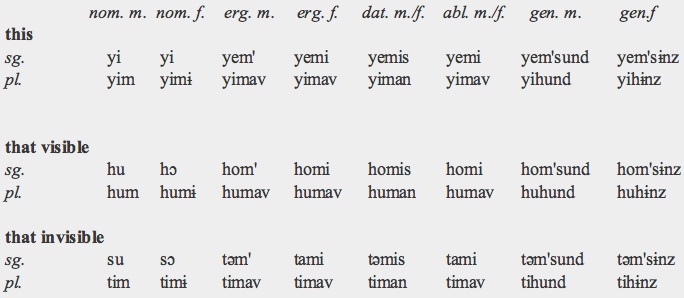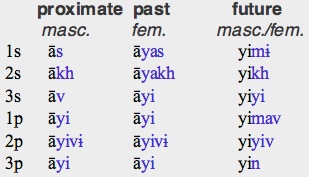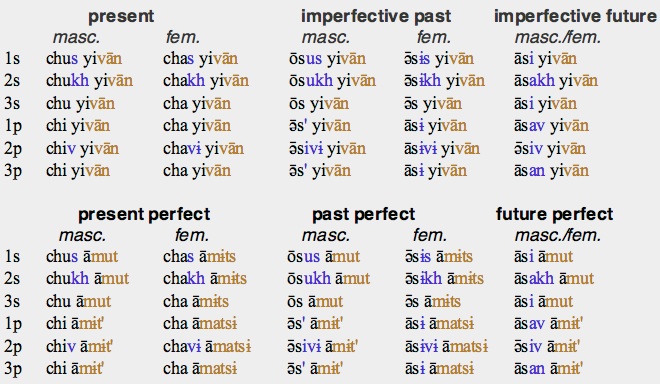An insatiable appetite for ancient and modern tongues


Classification: Indo-European, Indo-Iranian, Modern Indo-Aryan, North-Western, Dardic.
Overview. Kashmiri is the most prominent of a group of Indo-Aryan languages, called Dardic, spoken in the mountainous regions of northwestern India and northeastern Pakistan. It is the largest Dardic language and the only one that produced an early literature. Separated from the main Indo-Aryan languages and close to the Iranian world, Kashmiri preserved some archaic features while developing unique traits at the phonological, morphological and syntactical levels.
Distribution and Speakers. The core of the 6.5 million Kashmiri speakers lives in the Vale of Kashmir and the surrounding hills, situated in the west of the Indian state of Jammu and Kashmir. Kashmiri is also spoken in other northern Indian states, as well as in north-east Pakistan where they total about 100,000.
Status. Urdu is the official language of Jammu and Kashmir but Standard Kashmiri, spoken in the city of Srinagar, is employed in elementary education, mass media and literature. Language usage is affected by religious and social differences, namely between Hindus and Muslims, between the cities and the countryside.
Varieties. Within the Kashmir valley dialectal differences are minor, the standard language is that of the capital Srinagar. Outside the valley, the only important dialects are Kishtwari (Kishtwar valley, south-east of Kashmir valley) and Poguli (south of Banihal city, to the west of Kishtwar). Rambani and Siraji, spoken also outside the valley, are more related to Dogri than to Kashmiri.
Oldest Document. The earliest record of Kashmiri is a group of 94 stanzas embedded in the Mahānaya-prakāśa ('Illumination of the Highest Attainment'), a Sanskrit philosophical work dating from the 14th-15th century.
Phonology
Vowels (15). Kashmiri, in contrast to most Modern Indo-Aryan languages, has several central vowels. Most vowels have nasal forms. Length and nasalization are phonemic.

-
[ɔ] occurs in a few words only.
Consonants (27). The Kashmiri consonantal system is remarkable for a couple of innovations shared with other Dardic languages. One is the loss of aspiration of voiced stops leading to a three-way contrast (aspirated and unaspirated voiceless stops + unaspirated voiced stops) instead of the four-way contrast characteristic of Indo-Aryan languages (aspirated and unaspirated voiceless stops + aspirated and unaspirated voiced stops). Another novelty is the appearance of dental affricates (ts and tsʰ), and a third one is the acquisition of a voiced fricative (z).

In addition to this basic inventory of consonants, Kashmiri has borrowed phonemes from Arabic and Persian which are used, exclusively, in imported words.
Script and Orthography
Kashmiri was written initially in Śāradā, a script derived from Brāhmī. After the propagation of Islam in the area, Muslims adopted the Urdu (Arabo-Persian) script to write the language. Hindus, on the other hand, continued to use Śāradā which later was replaced by Devanāgarī. However, Śāradā is still used for ritual and religious purposes by some brahmans.
Kashmiri’s version of the Arabo-Persian script follows the same conventions of the Urdu script, but in contrast to it vowels are frequently indicated. There is some redundancy in this script because several letters reflect the orthography of the numerous loanwords from Persian and Arabic. In the 1st column the Arabo-Persian letter is shown, in the second its equivalent in the International Phonetic Alphabet, in the third one its transliteration into the Latin alphabet and in the last one another transliteration, close to the IPA, followed in some grammars and in this article.



Morphology
-
Nominal. Nouns are inflected for gender, number and case. Adjectives precede, and agree with, their nouns. Syntactical functions are marked mainly by postpositions in conjunction with cases.
-
•gender: masculine, feminine. The feminine is made by adding certain suffixes (-en', -in', -ə̄n', -bāy, -ɨr) to masculine forms and/or by vocalic and consonantal changes. Some feminines are suppletive i.e. consisting of a form unrelated to the masculine one. Nouns denoting certain species of animals are either only masculine or only feminine.

-
•number: singular, plural. Masculine plurals are formed from the singular by palatalization of the final consonant and/or vowel changes. Feminine plurals are usually made by adding the suffix -i/-ɨ with vowel and consonantal changes. Uncountable nouns, body parts and many loanwords have the same form for singular and plural.
-
a) masculine
-
-palatalization and vocalic change: mōl ('father') →mə̄l' ('fathers')
-
-palatalization: gur ('horse') → gur' ('horses')
-
-vocalic change: latšul ('broom') → latšɨl ('brooms'); gagur ('mouse') → gagar ('mice')
-
-masc. nouns ending in ɨ are invariable: makānɨ ('house/houses')
-
-CVC masc. nouns with central vowel a don't change: khar ('donkey/donkeys')
-
-nouns borrowed from English ending in consonant don't change hōṭal ('hotel/hotels')
-
b) feminine
-
-suffixation (-i) and vocalic change: kūr ('girl') → kōri ('girls')
-
-suffixation (-i) and vocalic + consonantal changes: lə̄nḍ ('branch') → lanji ('branches')
-
-suffixation (-i) and vowel deletion (ɨ): gagɨr ('rat') → gagri ('rats')
-
-suffixation (-ɨ): kath ('story') → kathɨ ('stories')
-
-consonantal and vocalic change: rāth ('night') → rə̄ts ('nights')
-
-invariable əch ('eye/eyes')
-
•case: nominative-absolutive, ergative, dative, ablative, vocative (optional).
-
Case function varies according to context. For example, the unmarked nominative-absolutive is used for subjects as well as for inanimate direct objects and animate direct objects in the simple past. Kashmiri is an ergative-absolutive language i.e. transitive verbs conjugated in the simple past agree with their object (which takes the absolutive) in gender and number while the subject adopts the ergative case. Intransitive verbs, and transitive verbs conjugated in other tenses, agree with their subject which is marked in the nominative case.
-
The dative is used primarily for direct and indirect objects as well as for expressing benefactive and comitative senses. Besides, it marks the subjects of verbs expressing mental or physical states, belief, knowledge and desire. The ablative indicates provenance and instrument. Genitive and locative senses are conveyed by the dative or ablative in conjunction with some postpositions.
-
Cases are marked by the following suffixes:

-
1. masculine nouns that form their plural by palatalization use their palatalized plural forms as ergative singular. They serve also as the base for the dative which uses the suffix -is instead of the regular -as e.g. mə̄l'is ('to the father').
-
The declension of typical masculine and feminine nouns is:

-
-
The vocative is optional and may be expressed by a particle followed by a noun in the vocative case e.g. hayā ləḍkā, hayō ləḍkav, hayē kūriy, hayē kōrev.
-
Some postpositions require their complements to take the dative, others the ablative, others both. Locative and comitative postpositions take the dative like k'uth ('for'), andar ('in/inside'), sān ('with, together with'). Postpositions that indicate direction or function as comitatives may take the ablative e.g. manzɨ ('from within'), peṭhɨ ('from'), sɨ̄th' ('with, by means of'). Postpositions expressing possession of inanimate singular nouns and proper nouns govern the ablative while possession of other nouns is expressed by the dative.
-
•pronouns: personal, reflexive, demonstrative, interrogative, relative, indefinite.
-
Personal pronouns are genderless and do not have a form for the 3rd person; demonstrative pronouns, which distinguish gender, are used, instead. They are declined in the same cases as nouns with the addition of the genitive (which agrees with the number, gender and case of the possessed noun). The ergative, dative and ablative are morphologically identical. Besides, Kashmiri has a reflexive pronoun that is inflected for case but not for person and number.

-
Demonstrative pronouns mark three deictic degrees: proximal, distant within sight, invisible. They are fully inflected and differentiate gender in the nominative, ergative and genitive.

-
There is a fourth demonstrative pronoun (nominative ti, dative/ablative tath) used only with inanimate nouns that are not visible.
-
Kashmiri has two fully inflected interrogative pronouns: kus ('who?') and k'ā ('what?'). Besides, there are several other interrogative words: kar ('when?'), k'āzi ('why?'), kati ('where?'), kithɨ kɨn' ('how?'), etc.
-
The relative pronoun is yus (masc. sg.), yɔsi (fem. sg.), yi (inanimate. sg.), yim (masc. and inanimate pl.), yimɨ (fem. pl.).
-
The main indefinite pronoun is kā̃h, meaning 'someone, anyone, something'. Its plural is kẽh. It is declined for case but the variant form kā̃htšah (plural kē̃htšah) is not.
-
Verbal. Like in other modern Indo-Aryan languages, the Kashmiri verbal system relies on compound tenses but in contrast with them the tense-mood auxiliary is placed to the left of the main verb. It is also peculiar in not distinguishing habitual and continuous tenses, or definite from contingent future. Pronominal clitics referring to direct and indirect objects are included in some tenses. Most verbal roots end in a consonant and only seven in a vowel (e or i).
-
•person and number: 1s, 2s, 3s; 1p, 2p, 3p.
-
•aspect: perfective, imperfective, perfect. Perfective aspect indicates a completed action, the imperfective an incomplete one (habitual, progressive or continuous), and the perfect a past action relevant to the present.
-
•tense: past and future are the only tenses that don't require an auxiliary verb. Besides them, there are compound tenses formed with the copula conjugated in the present, past and future + a lexical verb marked for imperfective or perfect aspect.

-
The proximate or simple past has a perfective aspect and is formed by adding pronominal suffixes, which distinguish gender, to the perfective/perfect stem. It expresses a recent past. Kashmiri has also an indefinite and a remote or historic past formed by adding specific infixes between the stem and the personal endings of the proximate past.
-
The future is formed by adding a different set of pronominal suffixes, which don't distinguish gender, to the imperfective stem. The conjugation of the verb yun ('to come') is shown in the table (perfective/perfect stem ā-, imperfective stem yi-)
-
The present and past copula are inflected for person, number and gender while the future copula is inflected only for person and number. In the imperfective tenses the lexical verb form is the present participle which is invariable. In contrast, in the perfect tenses the lexical verb form is the perfect participle which distinguishes gender and number.
-
black: roots; blue: personal endings; brown: participial aspect markers.

-
The English equivalent of each of the above tenses in the 3rd person is:
-
proximate past: He came (recently)
-
future: He will come
-
-
present: He comes/He is coming
-
imperfective past: He used to come/He was coming
-
imperfective future: He probably come/He will be coming
-
-
present perfect: He has come
-
past perfect: He had come
-
future perfect: He may/shall/must have come
-
•mood: indicative, conditional, imperative.
-
The conditional (or contrafactive) mood has simple, imperfective and perfect tenses. In the simple conditional the personal markers are attached directly to the verb root. In the imperfective and perfect conditionals the markers are attached to the auxiliary, instead. The imperfective conditional combines the auxiliary with the invariable present participle. The perfect conditional combines the auxiliary with the perfect participle which is inflected for gender and number.
-
For example, the conjugation of the verb parun ('to read') in the contrafactive is:

-
The English equivalent of each of the above tenses in the 3rd person is:
-
simple conditional: he would read/if he had read
-
imperfective conditional: he would have been reading/had he been reading
-
perfect conditional: he would have read/had he read
-
The imperative mood has different forms: unmarked, polite, prohibitive and obligative.
-
The unmarked imperative has only 2nd person; the singular is identical to the verb stem; the plural, which may be used as honorific, is marked by the suffix -(y)iv e.g. singular lēkh ('write!') and plural līkhiv.
-
The polite imperative uses the marker sə̄ to soften the command as in lēkh sə̄ ('please write'). Another form of the polite imperative is made by suffixing -tɨ (sg-) and -tav (pl.) to the verb stem.
-
The prohibitive imperative is expressed with the negative particle mɨ ('don't) in preverbal position (in contrast with the regular negative nɨ that is postverbal) e.g. kitāb mɨ par ('don't read a book').
-
The obligative imperative expresses duties or moral obligations, it is formed by adding the suffixes -izi (sg.) and -izev (pl/honor.) to the verb stem. For example: singular līkhizi ('you should write') and plural līkhizev.
-
•voice: active and passive.
-
•derivative conjugation: causative. Transitive verbs form the causative by adding -āv to roots ending in a vowel or -ɨnāv to roots ending in consonant. Intransitive verbs form the causative by suffixation (-āv, -ɨnāv, -ɨrāv) and/or vocalic change or by using a suppletive root:
-
vocalic change: mar ('die') → mār ('kill' i. e. 'make die')
-
suffixation: di ('give') → d'āv ('cause to give')
-
suffixation: dar ('be stable') → derɨrāv ('stabilize')
-
suppletion: yi ('come') → an ('bring')
-
•non-finite forms: infinitive, gerund, present participle, perfect participle.
-
Infinitives are formed by adding the suffix -un/-on to the verb root; if the root ends in a vowel this is elided and the consonant may be palatalized:
-
kar → karun ('to do')
-
vuch → vuchun ('to see')
-
yi → yun ('to come')
-
di → d'un ('to give')
-
pe → p'on ('to fall')
-
he → h'on' ('to buy')
-
The gerund, also known as conjunctive participle, expresses an action that precedes the main one; it is formed by adding -ith to the root and is not inflected. It has a negative form made with a different suffix: -nay after vowel, -anay after consonant:
-
kar → karith ('having done'), karanay ('not having done')
-
vuch → vuchith ('having seen'), vuchanay ('not having seen')
-
yi → yith ('having come'), yinay ('not having come')
-
di → dith ('having given'), dinay ('not having given')
-
The present participle is formed by adding -(v)ān to the imperfective stem and is not inflected.
-
The perfect participle is formed by adding to the stem a suffix which is inflected for gender and number: masculine singular -mut, masculine plural -mɨt', feminine singular -mɨts, feminine plural -matsɨ.
Syntax
Unlike the prevalent word order of Indo-Aryan languages, that of Kashmiri is mainly Subject-Verb-Object (Verb). In sentences with a main verb and an inflected auxiliary verb, the main verb occupies the final position while the auxiliary occupies the second one. Apart for the position of the verb, word order in Kashmiri is quite flexible. A variety of postpositions are employed in conjunction with case marking to determine syntactical functions.
Kashmiri is a split ergative language, i.e., ergativity is restricted to the past tense. Transitive verbs agree with their object in gender and number while the subject adopts the ergative case. Intransitive verbs agree with their subject which is marked in the nominative case.
Lexicon
Reflecting the history of the area, the Kashmiri lexicon is mixed, containing Dardic, Sanskrit, Punjabi, Arabic and Persian elements. Religious differences are evident in it, Muslims use a larger proportion of Perso-Arabic loanwords than Hindus who prefer Sanskrit loanwords.
Basic Vocabulary
one: akh
two: zah
three: tre
four: cōr
five: pā̃tṣ
six: she
seven: sath
eight: aṣṭh
nine: nav
ten: dah
hundred: hath
father: mol
mother: māj
brother: boy
sister: beni
son: necuv
daughter: kūr
head: kal
eye: ach
foot: kadam
heart: dil
tongue: zev
Key Literary Works
-
14th c. Lalla Vakyani (Lalla's Sayings). Lal Ded (Lallā Ded)
-
More than one-hundred devotional couplets dedicated to Śiva by a female ascetic who, disregarding conventional worship, sought direct communion with God.
early 15th c. Shruks. Nund Rishi
-
Proverbial sayings by one of the first Sufi mystics of Kashmir open to all religions.
-
16th c. Love Lyrics. Habba Khatun
-
Short love poems lamenting the separation of the poetess from her husband Yusuf Shah Chak, ruler of Kashmir.
-
18th c. Love Lyrics. Aranimal
-
Along with Lal Ded and Habba Khatun, Aranimal was one of the three great female poets of Kashmir. Her poems are little gems of subtlety and delicacy.
-
18th c. Ramavatara Carita. Prakasa Rama
-
A Kashmiri version of the traditional Sanskrit epic Ramayana, consisting of 1786 stanzas, some in Persian meter and the rest in the native Kashmiri meter.
-
© 2013 Alejandro Gutman and Beatriz Avanzati
Further Reading
-
-'Dardic'. E. Bashir. In The Indo-Aryan Languages, 905-990. G. Cardona & D. Jain (eds). Routledge (2007).
-
-'Kashmiri'. O. N. Koul. In The Indo-Aryan Languages, 991-1051. G. Cardona & D. Jain (eds). Routledge (2007).
-
-Kashmiri. A cognitive-descriptive grammar. K. Wali & O. N. Koul. Routledge (1997).
-
-Modern Kashmiri Grammar. O. N. Koul & K. Wali. Dunwoody Press (2006).
Kashmiri

Address comments and questions to: gutman37@yahoo.com
MAIN LANGUAGE FAMILIES
LANGUAGE AREAS
Languages of Ethiopia & Eritrea
LANGUAGES by COUNTRY
LANGUAGE MAPS
-
• America
-
• Asia
-
Countries & Regions
-
-
Families
-
• Europe
-
• Oceania